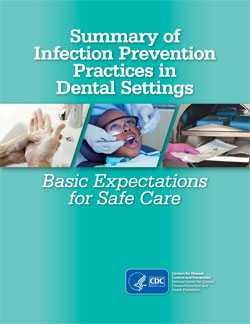Ensuring Safe Dental Care
 CDC has created new tools and resources to help dental staff better follow infection prevention recommendations in the dental setting.
CDC has created new tools and resources to help dental staff better follow infection prevention recommendations in the dental setting.
While rare, transmission of infection continues to occur in the dental setting. When an infection occurs in the dental setting, investigators often find that proper infection prevention practices were not used. In December 2003, CDC published Guidelines for Infection Control in Dental Health-Care Settings – 2003, a comprehensive and evidence-based resource for infection prevention recommendations in the dental office, developed to protect both dental staff and patients.
A CDC review found the guidelines to still be the standard of care, but there were documented occurrences of inconsistent compliance with recommended infection prevention practices. The 2016 Summary of Infection Prevention Practices for Dental Settings: Basic Expectations for Safe Care provides tools and resources to help dental staff adopt and follow appropriate infection prevention procedures described in the guidelines.

It is important that all dental health care personnel understand and follow infection prevention recommendations.
New Tools and Resources
The Summary of Infection Prevention Practices for Dental Settings: Basic Expectations for Safe Care includes several tools to help dental health care providers follow infection prevention guidelines. This resource includes:
- A Summary [1.03 MB] of basic infection prevention recommendations for the dental settings
- Links [1.03 MB] to references and additional resources
- An adaptable checklist [831 KB] to evaluate how well dental staff are following the guidelines
- New recommendations [1.03 MB] relevant to dentistry that CDC published after 2003
Together, the Guidelines for Infection Control in Dental Health-Care Settings–2003 and the Summary of Infection Prevention Practices for Dental Settings: Basic Expectations for Safe Care provide a comprehensive, evidence-based resource with step-by-step recommendations for adopting, implementing, and maintaining proper infection prevention practices as described by the guidelines.
- Page last reviewed: March 29, 2016
- Page last updated: March 29, 2016
- Content source:
- National Center for Chronic Disease Prevention and Health Promotion, Division of Oral Health
- Page maintained by: Office of the Associate Director for Communication, Digital Media Branch, Division of Public Affairs




 ShareCompartir
ShareCompartir